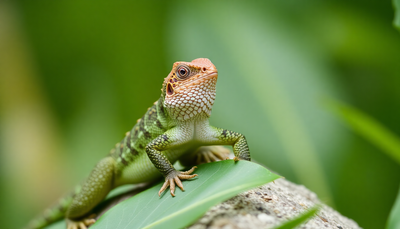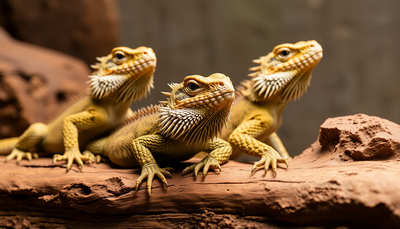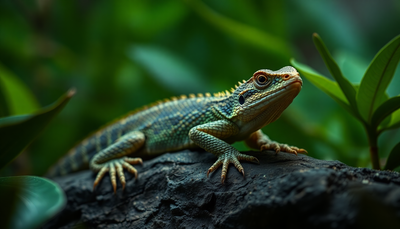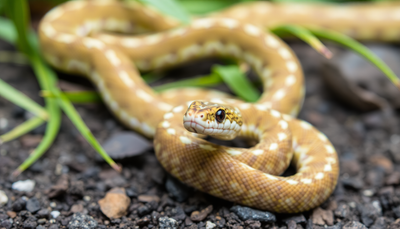
Anole Species Identification Made Simple: Your Complete Guide to Recognizing and Differentiating Anole Lizards

Anoles are a diverse group of small lizards known for their color-changing ability and distinctive throat fans. Understanding anole diet features empowers reptile enthusiasts and pet owners to recognize native and invasive species accurately. While Talis-Us excels in providing premium pet nutrition—including Freeze-Dried Treats – Talis-Us—this guide extends their commitment to animal care by equipping readers with clear methods to spot and differentiate anoles. In the sections that follow, readers will explore anole biology, key identification traits, comparisons among common species, geographic distribution, invasive-species insights, helpful field resources, typical queries answered, and best practices for ethical observation.
What Is an Anole and Why Is Identification Important?
An anole is a small, predominantly arboreal lizard characterized by a slender body, adhesive toe pads, and a retractable dewlap used in displays. Accurate species identification enables hobbyists to provide proper care, supports ecological monitoring, and helps track invasive populations. For example, distinguishing native green anoles from invasive brown anoles informs habitat management and conservation efforts.
What Defines an Anole Lizard?
- Long, tapered tail for balance and agility
- Suction-cup toe pads that facilitate climbing
- Extendable dewlap beneath the throat used for communication
- Head shape varying from blunt to pointed across species
These traits unify anoles as specialized climbers, and the dewlap leads naturally into understanding its role in identification.
Why Should You Learn to Identify Anole Species?
- Pet care by matching habitat and dietary needs
- Ecological research through accurate population surveys
- Conservation by detecting invasive spread early
Knowledge of species-specific requirements enhances both animal welfare and environmental stewardship, which in turn connects to habitat impact assessments.
How Do Anoles Impact Local Ecosystems?
- Insect predation that controls pest populations
- Competition with native lizards for territory and resources
- Serving as prey for birds, snakes, and mammals
Understanding these roles underscores why distinguishing native from non-native anoles is crucial for ecosystem health and guides us toward identification methods.
How Do You Identify Anole Species? Key Features to Observe

Identification hinges on observing anatomy, color, and behavior. By focusing on dewlap characteristics, body measurements, scale patterns, and coloration changes, observers can narrow down potential species within seconds.
What Role Does the Dewlap Play in Anole Identification?
The dewlap is a skin flap under the throat that varies among species in:
- Color range (e.g., bright pink, orange, yellow)
- Shape and edge pattern (rounded vs. scalloped)
- Relative size compared to head dimension
Because each major species displays a distinctive dewlap, analysts can often identify anoles at a glance by dewlap inspection.
The Diverse Roles of the Anole Dewlap in Communication and Identification
The dewlap, an extensible throat fan found in anole lizards, exhibits significant diversity in size, shape, color, and pattern across species. It serves as a crucial visual signal for social and sexual communication, species recognition, and territorial displays, making its characteristics vital for accurate anole species identification.
This citation verifies the article's emphasis on the dewlap as a primary identification feature and its various functions in anole biology and communication.
How Do Body Size and Shape Help Differentiate Anoles?
- Small species measure 3–5 cm from snout to vent
- Larger species exceed 10 cm snout to vent
- Robust body forms correlate with ground-dwelling species
- Slender, elongated forms align with highly arboreal species
These size and shape distinctions guide observers toward the correct species group and prepare for scale-pattern analysis.
What Scale Patterns and Textures Are Distinctive?
Anoles exhibit smooth or keeled scales with varying head scale arrangements. The table below compares common scale features:
| Feature | Smooth-Scaled Species | Keeled-Scaled Species |
|---|---|---|
| Body Surface | Shiny, uniform | Raised ridges, rough feel |
| Head Scale Arrangement | Large, flattened plates | Small, overlapping granules |
| Identification Tip | Reflects light evenly | Visible ridge lines |
Smooth versus keeled scales often separate closely related species and lead directly into color-based identification.
How Does Coloration and Color Change Affect Identification?
Anoles can shift from bright green to brown or gray based on mood, temperature, and background.
- Green hues indicate territorial or thermoregulatory displays
- Brown or gray camouflage appears when resting or stressed
- Transition speed and pattern intensity vary by species
By noting both baseline color and dynamic change responses, observers refine species determination, paving the way for geographic context.
What Are the Most Common Anole Species and How Can You Tell Them Apart?

Several anoles frequently encountered by hobbyists and researchers show clear trait contrasts. Comparing dewlap color, body size, and native range highlights these differences.
| Species | Dewlap Color | Typical Range | Snout-Vent Length |
|---|---|---|---|
| Green Anole | Pink to bright red | Southeastern United States | 5–8 cm |
| Brown Anole | Orange to yellow | Caribbean origin; invasive in FL | 4–6 cm |
| Knight Anole | Yellow to orange | Cuba; introduced in FL | 15–20 cm |
These direct comparisons clarify how trait values align with species identity, which leads to individual profiles below.
How to Identify the Green Anole (Anolis carolinensis)?
The Green Anole displays a unilateral dewlap, smooth scales, and slender build:
- Dewlap color: solid pink to red
- Body: bright green turning brown when cold
- Head: triangular profile with smooth cranial scales
This lizard’s native habitat in warm, humid woodlands differentiates it from more ground-oriented species.
How to Recognize the Brown Anole (Anolis sagrei) and Its Invasive Status?
Brown Anoles are invasive in Florida and characterized by:
- Dewlap color: vibrant orange edged with yellow
- Scales: pronounced keeled texture along the back
- Behavior: aggressive territorial displays
Their rapid spread in subtropical regions has displaced some native species, making accurate detection vital.
Rapid Evolutionary Adaptation and Competitive Displacement in Anole Lizards
Research indicates that the invasive brown anole (Anolis sagrei) outcompetes native green anoles (Anolis carolinensis) in the southeastern U.S., forcing native species to shift to higher perches. This competition has driven rapid evolutionary changes in green anoles, including the development of larger toe pads and more lamellae within as few as 20 generations, enabling better climbing in their new arboreal niche.
This research directly supports the article's discussion on the invasive status of the brown anole, its impact on native green anoles, and the subsequent evolutionary adaptations observed in native populations.
What Distinguishes the Knight Anole (Anolis equestris)?
Knight Anoles rank among the largest:
- Dewlap color: pale yellow to orange
- Snout-vent length: up to 20 cm
- Habitat: arboreal zones with high canopy cover
Their size and casque-like head crest clearly set them apart from smaller anoles.
Which Other Notable Anole Species Should You Know?
Beyond the big three, enthusiasts may encounter:
- Bark Anole – mottled body matching tree bark
- Cuban Green Anole – similar hue but smaller dewlap
- Hispaniolan Anole – slender form with elongated dewlap
Recognizing these lesser-known species refines overall identification skills.
Where Are Different Anole Species Found? Geographic Distribution and Habitat Insights
Regional occurrence often narrows species options faster than morphological details. Observers use location as a primary filter before examining anatomy.
What Anole Species Are Common in Florida?
In Florida, you’ll find:
- Green Anoles in forest edges and gardens
- Brown Anoles along sunny walls and ground cover
- Knight Anoles in shaded, lush backyard trees
This regional mix makes Florida a hotspot for both native and invasive identification challenges.
Which Anoles Inhabit Central America?
Central American rainforests host:
- Green-striped Anole (Anolis lineatus)
- Emerald Anole (Anolis chrysolepis)
- Many micro-endemics on volcanic slopes
These tropical species exhibit vivid patterns adapted to dense vegetation.
What Anole Species Live in South America?
Amazonian and Andean regions support:
- Blue-eyed Anoles with distinctive ocular rings
- Leaf-litter anoles blending with forest floor debris
- High-altitude specialists with thicker scales
Altitude and humidity gradients shape which species reside in specific biomes.
How Does Habitat Influence Anole Identification?
Habitat context informs:
- Color adaptation to foliage or substrate
- Body shape suited for canopy versus ground
- Display frequency influenced by light availability
Knowing where anoles live focuses morphological comparisons on a smaller candidate pool.
How Can You Identify and Understand Invasive Anole Species?
Invasive anoles disrupt ecosystems, so detecting them early relies on both field observations and an understanding of their impacts.
What Makes the Brown Anole an Invasive Species?
Brown Anoles thrive where:
- Human landscapes provide abundant sunlit perches
- Native competitors lack aggressive behavior
- Rapid reproduction fuels population booms
Their adaptability explains why they spread quickly beyond their Caribbean origin.
How Do Invasive Anoles Affect Native Populations?
Competition from invasives leads to:
- Declines in native anole abundance
- Reduced breeding success for less aggressive species
- Altered insect-prey dynamics
These ecological shifts highlight the importance of distinguishing invasive individuals in surveys.
What Identification Tips Help Distinguish Invasive Anoles?
Key pointers include:
- Compare dewlap color against native baseline hues
- Note scale texture differences under a magnifier
- Record perch height and behavior patterns
Using these cues ensures that invasive detections are both fast and accurate.
What Tools and Resources Can Help with Anole Identification?
Modern guides and community science platforms support rapid, reliable identification for field and hobby contexts.
Which Field Guides and Apps Are Best for Identifying Anoles?
Observers benefit from:
- Regional reptile field guides with color plates
- Smartphone apps like iNaturalist for image-based matching
- Printable dichotomous keys tailored by state or country
These resources bridge beginner and expert proficiency levels.
How Can Citizen Science Projects Assist in Anole Identification?
By contributing to initiatives such as:
- iNaturalist sightings to map distribution
- Local herpetological surveys for invasive tracking
- Online forums where experts verify submissions
Citizen science harnesses collective effort for large-scale monitoring.
Are There Interactive Identification Tools Available?
Interactive options include:
- Web-based filters by dewlap color, size, and location
- Quiz-style mobile apps with immediate species suggestions
- Augmented-reality overlays demonstrating scale patterns
Such tools accelerate learning and encourage ongoing engagement.
What Are the Most Frequently Asked Questions About Anole Identification?
This section addresses common identification challenges through concise, informative explanations that skip generic Q&A formatting and instead focus on direct, actionable information.
How Do You Identify an Anole Quickly and Accurately?
Observers should first note the dewlap’s hue and shape, then confirm body size and scale texture. Combining these traits with geographic data yields a reliable species match within moments.
What Is the Difference Between a Green Anole and a Brown Anole?
Green Anoles are typically bright green with a pink-red dewlap and smooth scales, while Brown Anoles are brown or gray with an orange-yellow dewlap and keeled scales. These features distinguish the two even when color shifts occur.
How Can You Tell If an Anole Is Male or Female?
Male anoles display larger, more vivid dewlaps and slightly bigger head crests, whereas females have smaller or absent dewlaps and lack prominent cranial features. Size differences also become apparent during breeding seasons.
Are All Anoles Native or Are Some Invasive?
Some anoles, such as the Brown Anole and Knight Anole, are non-native and classified as invasive in parts of the United States. Native species include the Green Anole and several localized Central and South American forms.
What Is the Most Common Anole Species in North America?
The Green Anole stands out as the most widespread native anole in the southeastern U.S., frequently encountered in gardens, parks, and suburban landscapes.
How Can You Observe and Contribute to Anole Identification Responsibly?
Ethical observation practices minimize disturbance and support conservation efforts by ensuring accurate, high-quality data collection.
What Are Best Practices for Observing Anoles in the Wild?
Observers improve data integrity by:
- Maintaining a respectful distance (at least 1 m)
- Using binoculars or a macro lens to avoid handling
- Recording precise location and environmental conditions
These habits foster trust and reduce stress on the animals.
How Can You Share Your Anole Sightings with Experts?
Reliable reporting channels include:
- Uploading geotagged photos to iNaturalist
- Submitting records to local herpetology societies
- Posting documented findings in vetted online communities
These platforms ensure expert validation and maintain data standards.
Why Is Responsible Observation Important for Conservation?
Accurate, ethically gathered data:
- Informs habitat protection measures
- Guides management of invasive populations
- Builds long-term species distribution records
Such contributions reinforce broader conservation goals and community science credibility.
Final observations of dewlap color, scale texture, and habitat context empower both novices and professionals to identify anole species confidently. By combining direct field methods with digital tools and ethical practices, observers can contribute meaningful insights to herpetology and conservation efforts.





